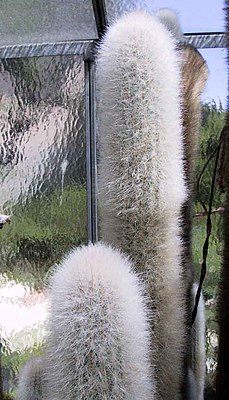Espostoa senilis
| Espostoa senilis | ||||||||||||
|---|---|---|---|---|---|---|---|---|---|---|---|---|

Espostoa senilis |
||||||||||||
| Systematics | ||||||||||||
|
||||||||||||
| Scientific name | ||||||||||||
| Espostoa senilis | ||||||||||||
| ( F.Ritter ) NPTaylor |
Espostoa senilis is a species of plant in the genus Espostoa from the cactus family(Cactaceae). The specific epithet senilis means 'senile'.
description
Espostoa senilis grows shrubby or tree-shaped with shoots branching from the base to about half the height and reaches heights of 2 to 4 meters. The slender, columnar, gray-green shoots are 4 to 6 centimeters in diameter and are completely covered by long white hairs . There are 17 to 18 scarcely tuberous ribs that are 6 to 8 millimeters high. The closely spaced areoles on it are covered with brownish gray wool. The one to three strong, yellowish-brown central spines are only developed late. They are up to 3 inches long. The more than 60 white radial spines occasionally have a darker tip and a length of up to 10 millimeters. The six to twelve ribs cephalium consists of brownish wool.
The purple flowers are 4.5 to 6 inches long and 3 to 4 inches in diameter. The spherical, green fruits have a diameter of up to 2 centimeters.
Distribution, systematics and endangerment
Espostoa senilis is common in Peru in the regions of Cajamarca , La Libertad and Ancash at altitudes of 2000 to 2500 meters.
It was first described as Thrixanthocereus senilis in 1961 by Friedrich Ritter . Nigel Paul Taylor placed the species in the genus Espostoa in 1978 .
In the Red List of Threatened Species of the IUCN , the species is listed as " Least Concern (LC) ". H. listed as not endangered.
proof
literature
- Edward F. Anderson : The Great Cactus Lexicon . Eugen Ulmer KG, Stuttgart 2005, ISBN 3-8001-4573-1 , p. 283 .
Individual evidence
- ↑ Cacti and other succulents . Volume 12, 1961, p. 89.
- ^ Cactus and Succulent Journal of Great Britain . Volume 40, Number 2, 1978, p. 54.
- ↑ Espostoa senilis in the IUCN Red List of Threatened Species 2013.2. Posted by: Ostalaza, C., Cáceres, F. & Roque, J., 2011. Retrieved March 9, 2014.